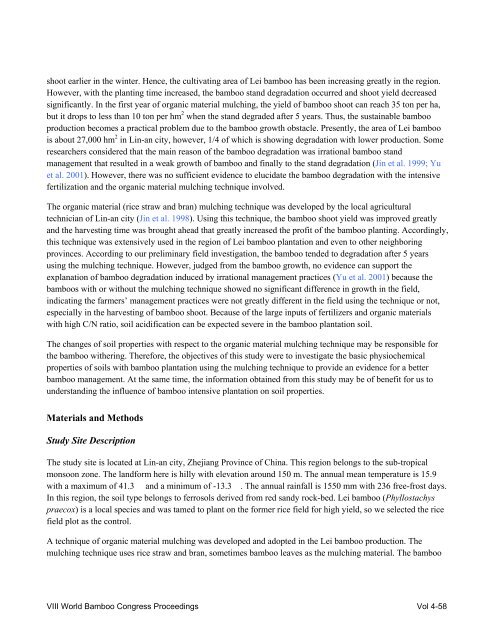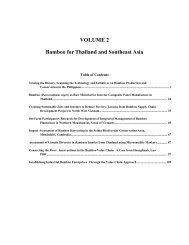WBC-VIII-Vol.4 – Resources – Forestry, Plantations and ... - BambuSC
WBC-VIII-Vol.4 – Resources – Forestry, Plantations and ... - BambuSC
WBC-VIII-Vol.4 – Resources – Forestry, Plantations and ... - BambuSC
Create successful ePaper yourself
Turn your PDF publications into a flip-book with our unique Google optimized e-Paper software.
shoot earlier in the winter. Hence, the cultivating area of Lei bamboo has been increasing greatly in the region.<br />
However, with the planting time increased, the bamboo st<strong>and</strong> degradation occurred <strong>and</strong> shoot yield decreased<br />
significantly. In the first year of organic material mulching, the yield of bamboo shoot can reach 35 ton per ha,<br />
but it drops to less than 10 ton per hm 2 when the st<strong>and</strong> degraded after 5 years. Thus, the sustainable bamboo<br />
production becomes a practical problem due to the bamboo growth obstacle. Presently, the area of Lei bamboo<br />
is about 27,000 hm 2 in Lin-an city, however, 1/4 of which is showing degradation with lower production. Some<br />
researchers considered that the main reason of the bamboo degradation was irrational bamboo st<strong>and</strong><br />
management that resulted in a weak growth of bamboo <strong>and</strong> finally to the st<strong>and</strong> degradation (Jin et al. 1999; Yu<br />
et al. 2001). However, there was no sufficient evidence to elucidate the bamboo degradation with the intensive<br />
fertilization <strong>and</strong> the organic material mulching technique involved.<br />
The organic material (rice straw <strong>and</strong> bran) mulching technique was developed by the local agricultural<br />
technician of Lin-an city (Jin et al. 1998). Using this technique, the bamboo shoot yield was improved greatly<br />
<strong>and</strong> the harvesting time was brought ahead that greatly increased the profit of the bamboo planting. Accordingly,<br />
this technique was extensively used in the region of Lei bamboo plantation <strong>and</strong> even to other neighboring<br />
provinces. According to our preliminary field investigation, the bamboo tended to degradation after 5 years<br />
using the mulching technique. However, judged from the bamboo growth, no evidence can support the<br />
explanation of bamboo degradation induced by irrational management practices (Yu et al. 2001) because the<br />
bamboos with or without the mulching technique showed no significant difference in growth in the field,<br />
indicating the farmers’ management practices were not greatly different in the field using the technique or not,<br />
especially in the harvesting of bamboo shoot. Because of the large inputs of fertilizers <strong>and</strong> organic materials<br />
with high C/N ratio, soil acidification can be expected severe in the bamboo plantation soil.<br />
The changes of soil properties with respect to the organic material mulching technique may be responsible for<br />
the bamboo withering. Therefore, the objectives of this study were to investigate the basic physiochemical<br />
properties of soils with bamboo plantation using the mulching technique to provide an evidence for a better<br />
bamboo management. At the same time, the information obtained from this study may be of benefit for us to<br />
underst<strong>and</strong>ing the influence of bamboo intensive plantation on soil properties.<br />
Materials <strong>and</strong> Methods<br />
Study Site Description<br />
The study site is located at Lin-an city, Zhejiang Province of China. This region belongs to the sub-tropical<br />
monsoon zone. The l<strong>and</strong>form here is hilly with elevation around 150 m. The annual mean temperature is 15.9<br />
with a maximum of 41.3 <strong>and</strong> a minimum of -13.3 . The annual rainfall is 1550 mm with 236 free-frost days.<br />
In this region, the soil type belongs to ferrosols derived from red s<strong>and</strong>y rock-bed. Lei bamboo (Phyllostachys<br />
praecox) is a local species <strong>and</strong> was tamed to plant on the former rice field for high yield, so we selected the rice<br />
field plot as the control.<br />
A technique of organic material mulching was developed <strong>and</strong> adopted in the Lei bamboo production. The<br />
mulching technique uses rice straw <strong>and</strong> bran, sometimes bamboo leaves as the mulching material. The bamboo<br />
<strong>VIII</strong> World Bamboo Congress Proceedings Vol 4-58




